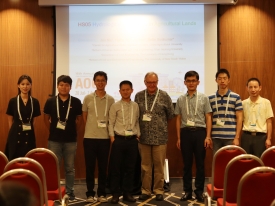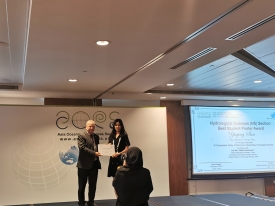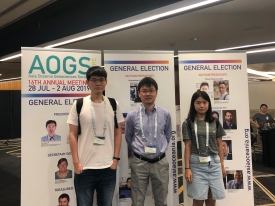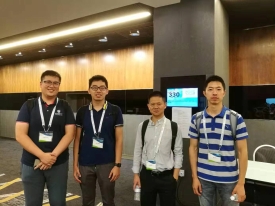



The 16th annual meeting of the Asia Oceania Geosciences Society (AOGS2019) has been successfully held in the Suntec Center in Singapore. Two of the Hydrological Sessions — Hydrological Processes in Agricultural Lands (HS05) and Land and Water Management for Sustainability (HS15) convened by Dr. Jun Niu from the Center for Agricultural Water Research in China (CAWR), has gained much attention from professors and researchers in Tokyo Institute of Technology, Nagasaki University and National Institute of Water and Atmospheric Research, Environmental Sciences and Research Ltd., Cambodia Institute of Technology, Vellore Institute of Technology, Tsinghua University, the University of Hong Kong, National United University, Southern University of Science and Technology, Xi’an Jiaotong University, Nanjing University, Beijing Normal University, Hohai University, Yunnan University, Chinese Academy of Agricultural Sciences and China Institute of Water Resources and Hydropower Research, among others.
Five members from our CAWR center as well as four graduate students had participated actively in this conference. Dr. Xu Xu gave a talk about an integrated numerical model for simulating agroecosystem process-model description and application and discussed specific modeling with others; Dr. Liu Liu with his graduate student Ruotong Wang presented transition characteristics from warm-dry to warm-wet and vegetation dynamic responses in the southeastern part of the Qinghai-Tibet plateau; Dr. Jun Niu presented a VIC-based cooling effects study for agricultural lands in Northwest China, Dr. Jun Niu and his graduate student Yue Dong shared sustainability of agricultural water use over an inland river basin in northwest China; Yuqing Sun conducted a presentation about development of a distributed agricultural drought prediction model. Dr. Xiao Zhao, Dr. Keyu Fa and graduate student Hao Li shared their work about dispersion, sorption and photodegradation of petroleum hydrocarbons in dispersant-seawater-sediment systems, underestimation of soil respiration in a desert ecosystem, and NDVI indicated dynamic variations in vegetation and their responses to climatic, respectively with posters.
In HS05 session, Dr. Huimin Lei from Tsinghua University presented the topic about tracking the dynamics of distribution and phenology of winter wheat-summer maize cropping system in the north China plain during 2001-2008; researchers from Korea Chonbuk National University gave a talk about assessing the hydrologic and water quality impacts using SWAT and APEX-paddy integrated model in paddy-dominant agricultural watershed; Dr. Fubo Zhao from Xi’an Jiaotong University discussed hydro-biogeochemical impacts of future climate change in a typical loess hilly-gully watershed on the loess plateau, China; researchers from Chungnam National University and K-water Research Institute gave a talk about estimation of water supply in agricultural reservoirs using empirical formula. In HS15 session, researchers from Tokyo Institute of Technology made a reassessment of reservoir sedimentation rates under monsoon climate with combined optical and microwave remote sensing, researchers from Canterbury and Cambodia Institute of Technology made an assessment of irrigation and hydropower impacts in the Tonle Sap basin; specialists from Vellore Institute of Technology presented estimation of south-west monsoonal surface runoff by using SCS-CN method for an ungauged watershed in Kodagu, India; Dr. Yiping Wu from Xi’an Jiaotong University presented satellite evidence for carbon and water consequences of the ‘Grain for Green’ program in Chinese loess plateau; Dr. Shailesh Singh from National Institute of Water and Atmospheric Research presented characterizing flow pathways across the landscape to characterize the linkages between land and water quality impacts.
There were also discussions of posters from Korea Rural Community Corporation, Hong Kong University and Chinese Academy of Agricultural Sciences in HS05 session, which were about the impact assessment of agricultural non-point source pollution on water quality in Saemangeum Reservoir, study on the discharge characteristics of pollution load from upland in reclaimed Saemangeum area, the relationship between soil moisture and vegetation with severe droughts in California and comparison of maize water consumption at different scales between mulched and non-mulched croplands. Moreover, there were discussions of posters from Nagasaki University, China Institute of Water Resources and Hydropower Research, Nanjing University, Beijing Normal University, Yunnan University, National United University, National Chung Hsing University in HS15 session, which were about analysis of water quality change and its factors before and after natural disasters in the Shimabara Springs, the present situation of the sponge city construction in China and the case study of Xiamen city, ecological risk assessment of the coastal area of Yancheng China, temporal and spatial variations in water discharge and sediment load on the loess plateau, China: a high-density study, using 137Cs and 210Pbex measurements to estimate soil erosion tares under different land use in the dry-hot valley region, southern China and evaluation of impacts of land use and land cover change on watershed response and crop yield.
The graduate student Yuqing Sun won the Hydrological Sciences Section Best Student Poster Award by through ‘A Comparative Study of Short-term Streamflow Forecasting Models’, which was the first time for graduate student from our department of water conservancy engineering to win this award in AOGS. AOGS president David Higgitt gave her the award in the closing ceremony.
In addition, Dr. Jun Niu was invited as the expert of hydrology session to take part in the ’Meeting the Experts’ international student program in July 31, and made academic discussions and academic writing discussions with Chinese and foreign graduate students on regional water and carbon processes using numerical models.